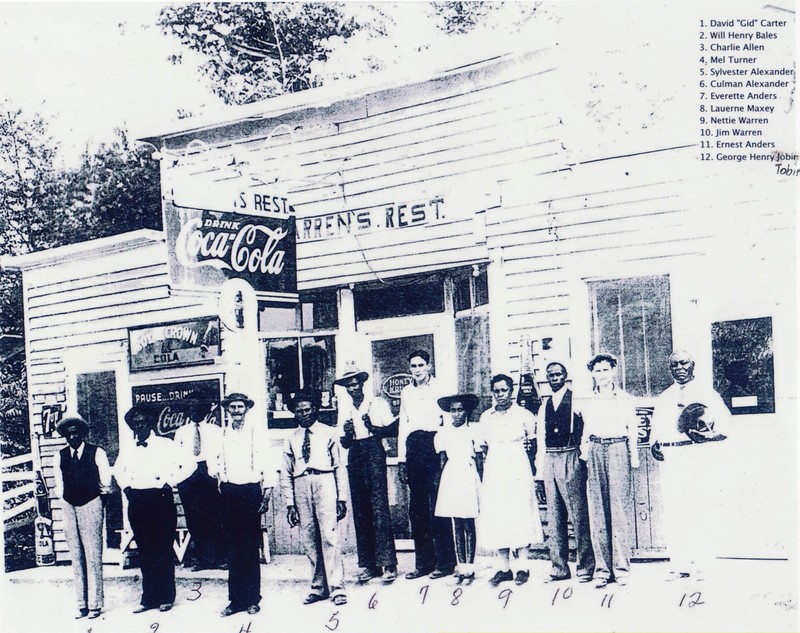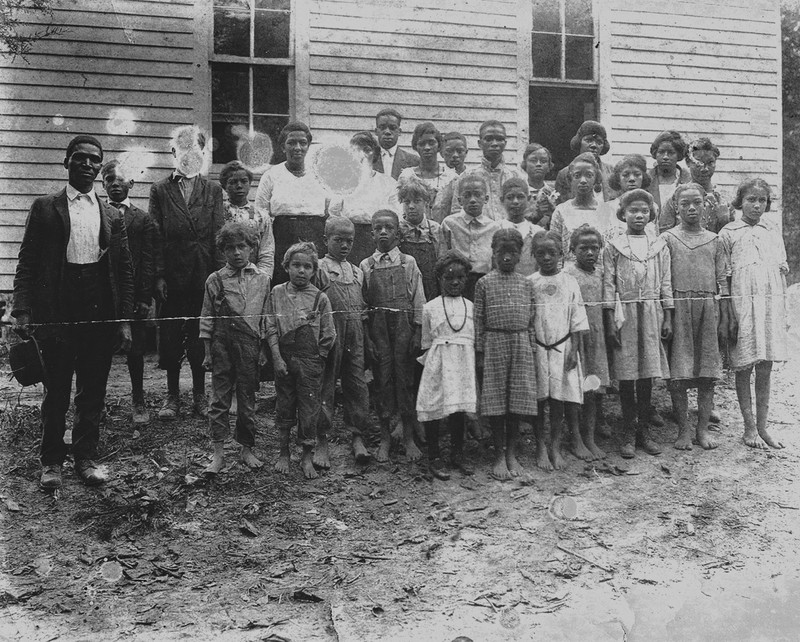Coe Ridge Colony aka Zeketown
Introduction
Text-to-speech Audio
Images
Residents of Coe Ridge in front of local business.

School children and their teacher at the Coe Ridge Colony.

Backstory and Context
Text-to-speech Audio
Ezekiel Coe like many other slaves raised additional crops for income. John Coe, Ezekiel’s owner permitted him to plant tobacco on the Coe Plantation. Ezekiel raised tobacco for two decades saving his money to purchase his freedom. “When freedom came automatically at the end of the War, Zeke took his cash accumulation, and, acting upon the advice of Master Coe, purchased 300-400 acres of raw, primitive ridge land on the back of the Coe plantation.”[1]
Once freed, Ezekiel began the process of reuniting his scattered family. He and his wife Patsy Ann started a family having nine children. As Ezekiel and his family settled into Coe Ridge more people came to the area. Eventually a sizable number of Blacks, mulattoes, and whites settled at the Coe Ridge Colony. The land filled with virgin timber provided wood to build homes and earn extra income. Farming and gathering of wild chestnuts provided food and additional income.
From emancipation to the 1880s, the colony grew prosperous and lived peacefully. However, some white residents living nearby the colony became resentful. Growing tensions mounted and several white neighbors began harassing children of the colony. This led to several people being killed on both sides of the conflicts.
By the 1920s, residents of the colony started moonshining and bootlegging to generate money for the colony. Illicit activities brought the attention of federal revenue agents who continually raided the colony. Additional harassment from federal agents compounded the continued harassment from racist neighbors from the 1920s to 1950s. During these years, the colony's reputation for harboring outlaws and rejected whites increased. However, by 1958, virtually all residents of Coe Ridge left for industrial jobs in Ohio, Virginia, Pennsylvania, Virginia, and Illinois.
There are very few surviving accounts of the Coe Ridge Colony. William Lynwood Montel a retired anthropology professor of Western Kentucky University published The Saga of Coe Ridge: A Study in Oral History in 1981. Montell uses oral histories to reconstruct the history of Coe Ridge Colony. One of the most important sources comes from Samuel S. Coe, born in 1879, and a grandson of Ezekiel Coe. Samuel Coe published the Chronicles of the Coe Colony in 1930 and the book was republished in 2007. Coe Ridge, born out of the Civil War, persevered through Reconstruction, Jim Crow, Prohibition, and two World Wars. Nestled in Cumberland County, Kentucky, the Coe Ridge Cemetery if the only physical remnants of the lost colony.
[1] William Lynwood Montell, “Saga of Coe Ridge: A Study in Oral History,” American Anthropologist, Vol. 74, Issue 3, June 1972. Pp. 713.
Sources
William Lynwood Montell, “Saga of Coe Ridge: A Study in Oral History,” American Anthropologist, Vol. 74, Issue 3, June 1972. Pp. 713. Coe, Samuel S. The Chronicles of the Coe Colony. Kansas City, Kansas, 1930. Montell, William Lynwood. The Saga of Coe Ridge: A Study In Oral History. Univ Tennessee Press, 1981. Guffy, Bill N. Fire in the Hole: An Oral History of Moonshine and Murder in Cumberland County, Kentucky. Burkesville, KY: Xerxes Publishing, 2007.
